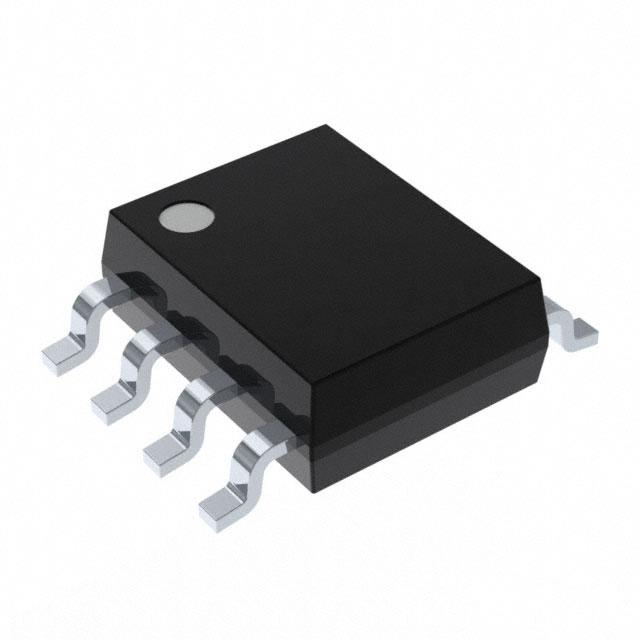AT24C16C-SSHM-T Setup for Embedded Sensor Storage

The AT24C16C-SSHM-T low power wide voltage embedded controller is a low-power memory chip that excels at saving sensor data in small systems. This AT24C16C-SSHM-T chip ensures data safety even during power outages, making it ideal for projects that require long-term data storage. It has the capacity to hold 16 Kbit (2K x 8) of data and can endure over 1 million erase and write cycles, ensuring its longevity. With its minimal power consumption, it is particularly beneficial for small systems; in standby mode, it draws up to 6 µA, while reading consumes 0.4 mA and writing uses 2 mA.
This chip is capable of preserving data for up to 200 years at 85°C. The AT24C16C-SSHM-T is highly reliable for critical sensor data. This guide will demonstrate how to set it up for your projects.
Key Takeaways
The AT24C16C-SSHM-T chip can hold 16 Kbit of data. It works for over 200 years, great for saving sensor data long-term.
Link the SDA and SCL pins to your microcontroller. Add pull-up resistors to keep the connection steady.
Set the chip's I2C address using the A0, A1, and A2 pins. This lets many chips share one I2C bus without mix-ups.
Always check if the chip answers before reading or writing data. This finds issues early and keeps your system working well.
Use the Write Protect pin to stop accidental data changes. This is helpful during updates or fixing problems.
Hardware Setup for AT24C16C-SSHM-T

Pin Configuration and I2C Connections
To use the AT24C16C-SSHM-T chip, learn its pin setup. This chip has eight pins, each with a specific job. The SDA (Serial Data) and SCL (Serial Clock) pins are key for I2C communication. These pins let the chip send and receive data with your microcontroller.
Connect the SDA and SCL pins to your microcontroller's I2C pins. Make sure the connections are tight to avoid errors. The VCC pin powers the chip, and the GND pin connects to ground. Use the WP (Write Protect) pin to stop accidental data changes. Set the address pins (A0, A1, A2) to high or low to pick the chip's I2C address. This lets you use more than one chip on the same I2C bus.
Power Supply and Voltage Requirements
The AT24C16C-SSHM-T works well with different voltage levels. It needs power between 1.7V and 5.5V. Use a steady power source to keep the chip safe.
This chip uses very little power, which is great for battery systems. In standby mode, it uses only 6 µA. Reading needs 0.4 mA, and writing uses 2 mA. This helps batteries last longer.
The chip is tested to handle tough conditions. It meets strict industrial and commercial standards. This makes it reliable and long-lasting, even in hard environments.
Using Pull-Up Resistors for I2C Communication
Pull-up resistors are important for I2C communication. They keep the SDA and SCL lines stable when no device is using them. Without pull-up resistors, the lines might act unpredictably.
Attach pull-up resistors to the SDA and SCL lines. A common resistor value is 4.7 kΩ, but you can change it if needed. Connect the resistors between the I2C lines and the VCC pin. This setup keeps the lines high when not in use.
Pull-up resistors make I2C communication more reliable. This is crucial for the AT24C16C-SSHM-T chip. They ensure smooth data transfer between the chip and your microcontroller.
Software Configuration for AT24C16C-SSHM-T
Starting I2C Communication
To use the AT24C16C-SSHM-T, set up I2C communication. I2C is a simple way for devices to share data using two wires: SDA (data) and SCL (clock). This makes it great for small systems.
First, turn on the I2C feature in your microcontroller. Many microcontrollers have built-in tools for this. For example, in Arduino, use Wire.begin() to start I2C. Make sure the SDA and SCL pins on your microcontroller match the AT24C16C-SSHM-T connections. Wrong connections can cause errors.
After enabling I2C, check if the chip is connected. Use tools or code examples to scan for devices on the I2C bus. If the AT24C16C-SSHM-T responds, you can move forward. Setting up I2C correctly ensures smooth data sharing and avoids problems like incomplete reads or writes.
Setting the AT24C16C-SSHM-T Address
The AT24C16C-SSHM-T can work with multiple devices on one I2C bus. Each chip needs its own address to avoid confusion. You can set this address using the A0, A1, and A2 pins on the chip. These pins let you pick one of eight addresses.
To set the address, connect each pin to VCC (high) or GND (low). For example, connecting A0 and A1 to GND and A2 to VCC gives the address 0x04. Check the datasheet for the full address list. Use this address in your microcontroller's I2C code to talk to the chip.
If two devices share the same address, communication will fail. Always double-check your setup to avoid conflicts. Correct address settings are key for smooth operation.
Creating a Simple Driver for the EEPROM
To use the AT24C16C-SSHM-T, you need a driver. A driver is software that helps you read and write data easily. A basic driver includes functions for storing and retrieving data.
Start by setting the chip's I2C address in your code. Then, write a function to send data to the chip. For example, in Arduino, use the Wire library to send a memory address and data. Here's an example:
#include <Wire.h>
#define EEPROM_ADDRESS 0x50 // Use your set address
void writeEEPROM(int memoryAddress, byte data) {
Wire.beginTransmission(EEPROM_ADDRESS);
Wire.write(memoryAddress >> 8); // High memory address
Wire.write(memoryAddress & 0xFF); // Low memory address
Wire.write(data);
Wire.endTransmission();
delay(5); // Wait for the write to finish
}
Next, create a function to read data from the chip. Use the memory address to choose where to read. Here's an example:
byte readEEPROM(int memoryAddress) {
Wire.beginTransmission(EEPROM_ADDRESS);
Wire.write(memoryAddress >> 8); // High memory address
Wire.write(memoryAddress & 0xFF); // Low memory address
Wire.endTransmission();
Wire.requestFrom(EEPROM_ADDRESS, 1);
return Wire.read();
}
These functions are the base of your driver. Test them to make sure they work well. Wrong memory access can cause errors or damage data. A good driver helps you use the AT24C16C-SSHM-T effectively.
Tip: Always check if the chip responds before reading or writing. This helps find problems quickly and keeps your system reliable.
Data Storage and Retrieval with AT24C16C-SSHM-T

Saving Sensor Data to the EEPROM
To save sensor data, write it to the EEPROM. First, pick the memory address where the data will go. Each address is like a specific box for storing data. Use your microcontroller to send the address and the data byte you want to save.
If you're using Arduino, the Wire library makes this easy. Always wait a little after writing so the EEPROM can finish saving. This ensures your data is stored properly. Writing data well helps you use the chip's storage space wisely.
Getting Sensor Data from the EEPROM
Reading data is as important as saving it. To get data, choose the memory address where it’s stored. The microcontroller will ask the EEPROM for the data, and the chip will send it back.
With Arduino's Wire library, this process is simple. Make sure the memory address is correct to avoid wrong data. Reading data correctly ensures you can trust the sensor information. This makes the AT24C16C-SSHM-T a reliable choice for small systems.
Example Code for Handling Data
Here’s an example to show how to save and read sensor data:
#include <Wire.h>
#define EEPROM_ADDRESS 0x50 // Use your chip's address
void saveSensorData(int memoryAddress, byte data) {
Wire.beginTransmission(EEPROM_ADDRESS);
Wire.write(memoryAddress >> 8); // High byte
Wire.write(memoryAddress & 0xFF); // Low byte
Wire.write(data);
Wire.endTransmission();
delay(5); // Wait for saving to finish
}
byte getSensorData(int memoryAddress) {
Wire.beginTransmission(EEPROM_ADDRESS);
Wire.write(memoryAddress >> 8); // High byte
Wire.write(memoryAddress & 0xFF); // Low byte
Wire.endTransmission();
Wire.requestFrom(EEPROM_ADDRESS, 1);
return Wire.read();
}
void setup() {
Wire.begin();
saveSensorData(0x0000, 42); // Save the value 42 at address 0x0000
byte data = getSensorData(0x0000); // Read the value from address 0x0000
Serial.begin(9600);
Serial.print("Read Data: ");
Serial.println(data);
}
void loop() {
// No repeated actions needed
}
This code saves a value to the EEPROM and reads it back. Change the memory address and data to fit your project.
Best Practices for AT24C16C-SSHM-T Integration
Optimizing Read/Write Operations
Smart read and write actions help your AT24C16C-SSHM-T last longer. Avoid writing data unless it has changed. Writing too often wears out the chip. Compare new sensor data with stored data before writing.
When saving many bytes, use page write. This lets you save up to 16 bytes at once. It reduces the number of write commands needed. Align your data to page edges to avoid overwriting other memory.
Wait a short time after each write. The chip needs this time to finish saving. Skipping the wait can cause data problems. Follow the datasheet's timing rules for best results.
Ensuring Data Integrity and Security
Keeping your data safe is very important. After writing, check the saved data by reading it back. This ensures the data matches what you wanted to save.
Use the Write Protect (WP) pin to stop accidental changes. This is helpful during updates or debugging. Lock important memory areas with this feature.
Electrical noise can harm your data. Use shielded wires and good grounding to reduce noise. Place decoupling capacitors near the chip to block interference. These steps keep your data safe in noisy places.
Troubleshooting Common Issues
Fixing problems quickly is important. Here are some common issues and fixes:
I2C Communication Failures: Check pull-up resistors. Wrong values can cause errors. Use buffers for long wires or many devices.
Electrical Noise and Interference: Use shielded wires and good grounding. Add capacitors to block noise and steady the power.
Incorrect Memory Access: Don’t access memory outside the chip’s range. Be careful with page edges to avoid overwriting nearby data.
Follow these tips to make your AT24C16C-SSHM-T work well in your projects.
Setting up the AT24C16C-SSHM-T has a few main steps. First, connect the hardware correctly. This includes pin connections, power supply, and pull-up resistors for I2C. Then, set up the software by turning on I2C, setting the address, and making a driver to handle data. Lastly, save and read sensor data carefully while using good practices for reliability.
A proper setup keeps your sensor data safe and easy to use. Follow these steps to add the AT24C16C-SSHM-T to your projects with ease.
Start now and use these tips to improve your system!
FAQ
1. What is the maximum storage capacity of the AT24C16C-SSHM-T?
The AT24C16C-SSHM-T can store 16 Kbit (2K x 8). This is enough to save a lot of sensor data for small projects.
2. How do you prevent accidental data overwrites?
Turn on the Write Protect (WP) pin to keep data safe. This stops changes to certain memory areas, protecting your important information.
3. What happens if the power supply fluctuates during operation?
The AT24C16C-SSHM-T can handle power changes well. Add decoupling capacitors near the chip to steady the power and protect your data.
4. Can multiple AT24C16C-SSHM-T chips share the same I2C bus?
Yes, you can use more than one chip on the same I2C bus. Give each chip its own address using the A0, A1, and A2 pins to avoid problems.
5. How do you verify data integrity after writing to the EEPROM?
After saving data, read it back to check if it’s correct. This step makes sure your data is accurate and reliable.
Tip: Follow the datasheet rules for timing and power to keep the chip working well for a long time.
See Also
Managing Data Storage and Configuration for AT24C02C-SSHM-T Chip
Implementing EEPROM Storage Solutions for PIC12F1822 Sensor Nodes
Ensuring Reliable Data Storage Through W25Q128FVSIG Programming
Achieving SPI Communication Mastery Using W25Q32JVSSIQ Chip
Exploring The Advantages Of STM32L151C8T6A In Sensor Technology

